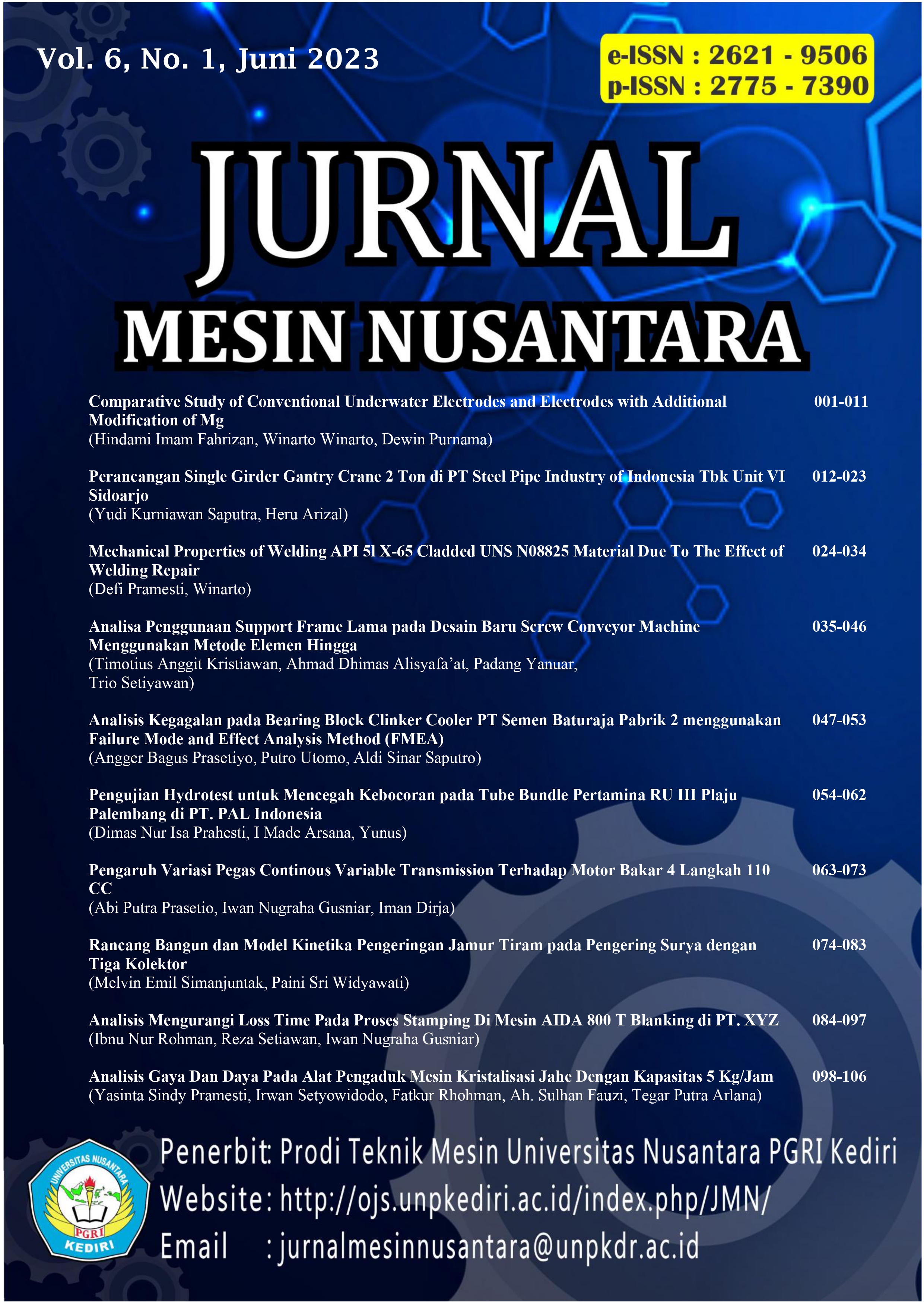Comparison study of conventional underwater electrodes and electrodes with additional modification of mg
DOI:
https://doi.org/10.29407/jmn.v6i1.18161Keywords:
Underwater Welding, Wet Welding, SMAW, Electrode DevelopmentAbstract
The influence of water depth, microstructure, chemical composition, welding defects, and mechanical properties affect underwater welding. In addition, the determination of electrodes for underwater welding requires unique properties, including being able to cause arcing and slag to grow on the surface of metal deposits which can protect against the effects of oxides and low hydrogen solubility. The electrodes must meet the AWS D3.6M underwater welding specification standard. In this study, the steel plate material used in AH-36 and implemented for underwater wet welding by comparing two electrodes, namely E6013 with additional Mg modifications and Broco E70XX electrodes specifically for underwater wet welding, the other Mg on E6013 rutile electrodes with modification 1 ( 3% Mg) and Modification 2 (5% Mg). The welding method with a heat input of 1.5 kJ/mm with 130 A and 2.5 kJ/mm with 140 A is carried out at 5m. The radiographic test results showed that the welded specimens at a depth of 5m showed imperfect penetration defects. It may be due to the effect of significant pressure and higher cooling rate that the weld melt cannot penetrate completely into the parent material. The tensile test results also showed an insignificant increase in the strength of the underwater welding, and the elongation was quite significant. Occurs at the E6013 electrode with modification 1 (3% Mg) and Modification 2 (5% Mg). The increase is not too significant. Penetration is not perfect. Due to significant pressure and a higher cooling rate, the molten weld cannot penetrate completely into the parent material. However, for testing the Broco E70XX electrode where there is no change in microstructure, such as electrodes modified with magnesium where only grain growth occurs, and there is Spheroidite which makes the microstructure related to mechanical properties, namely ductile.
Downloads
References
D. Purnama, W. Winarto, N. Sofyan, A. Prihastomo, and K. Ito, “Microstructure and mechanical properties of ah-36 steel weldment welded using magnesium modified E6013 electrode,” Int. J. Technol., vol. 11, no. 1, pp. 48–59, 2020, doi: 10.14716/ijtech.v11i1.2737.
R. P. Campos, A. C. Cuevas, and R. A. Esparza Muñoz, “Characterization of metals and alloys,” Charact. Met. Alloy., pp. 1–255, 2016, doi: 10.1007/978-3-319-31694-9.
C. E. Grubbs, M. F. Bluem, and P. T. Delaune, “Overview of ‘Specifications for Underwater Welding’ Aws D3. 6.,” pp. 221–226, 1983, doi: 10.1016/b978-0-08-030537-0.50023-5.
H. Ozaki, J. Naiman, and K. Masubuchi, “Study of Hydrogen Cracking in Underwater Steel Welds.,” Weld. J. (Miami, Fla), vol. 56, no. 8, pp. 231–237, 1977.
A. Sanchez-Osio, S. Liu, D. L. Olson, and S. Ibarra, “Designing Shielded Metal Arc Consumables for Underwater Wet Welding in Offshore Applications,” J. Offshore Mech. Arct. Eng., vol. 117, no. 3, pp. 212–220, Aug. 1995, doi: 10.1115/1.2827092.
X. Guirong, G. Xuesong, Q. Yuliang, and G. Yan, “Analysis and Innovation for Penetrant Testing for Airplane Parts,” Procedia Eng., vol. 99, pp. 1438–1442, 2015, doi: 10.1016/j.proeng.2014.12.681.
D. L. Olson, T. A. Siewert, S. Liu, and G. R. Edwards, “Welding, Brazing, and Soldering Volume 6 of the Asm Handbook.,” Asm Int., vol. 74, no. 8, pp. 269–278, 1993.
D. Fydrych et al., “Weldability of S500MC Steel in Underwater Conditions,” Adv. Mater. Sci., vol. 14, no. 2, pp. 37–45, 2014, doi: 10.2478/adms-2014-0008.
K. R. Manikandan, P. Ashwin Sivagurunathan, S. S. Ananthan, A. Arul Marcel Moshi, and S. R. Sundara Bharathi, “Study on the influence of temperature and vibration on indications of liquid penetrant testing of A516 low carbon steel,” Mater. Today Proc., vol. 39, no. xxxx, pp. 1559–1564, 2020, doi: 10.1016/j.matpr.2020.05.572.
W. Gao, D. Wang, F. Cheng, X. Di, C. Deng, and W. Xu, “Microstructural and mechanical performance of underwater wet welded S355 steel,” J. Mater. Process. Technol., vol. 238, pp. 333–340, 2016, doi: 10.1016/j.jmatprotec.2016.07.039.
Downloads
Published
Issue
Section
License
Authors who publish with this journal agree to the following terms:
- Copyright on any article is retained by the author(s).
- The author grants the journal, right of first publication with the work simultaneously licensed under a Creative Commons Attribution License that allows others to share the work with an acknowledgment of the work’s authorship and initial publication in this journal.
- Authors are able to enter into separate, additional contractual arrangements for the non-exclusive distribution of the journal’s published version of the work (e.g., post it to an institutional repository or publish it in a book), with an acknowledgment of its initial publication in this journal.
- Authors are permitted and encouraged to post their work online (e.g., in institutional repositories or on their website) prior to and during the submission process, as it can lead to productive exchanges, as well as earlier and greater citation of published work.
- The article and any associated published material is distributed under the Creative Commons Attribution-ShareAlike 4.0 International License












